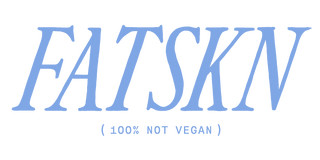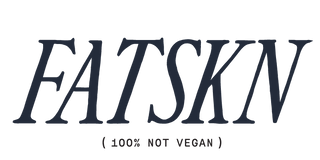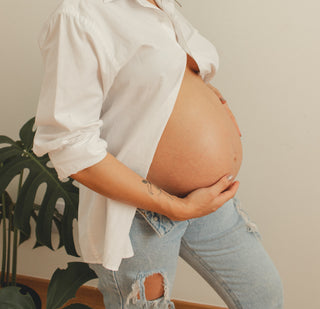First of all, congratulations.
Growing a tiny human is one of the most profound things the human body can do.
Whether you're trying to conceive, have one on the way, or recently gave birth— what a magical season you’re in.
As a fellow momma who just had my third, I know what it’s like to witness your body gear up for pregnancy.
Hormones loosen joints and widen your hips.
Your breasts grow and prepare to feed.
And, of course, your skin stretches to accommodate your growing baby.
All this change is necessary and oh-so-beautiful, but it often damages the skin and results in permanent stretch marks.
While these “pregnancy stripes” are nothing to be ashamed of, they could be a sign that your skin needs some more support.
Let’s explore why almost 90% of women experience stretch marks during pregnancy and what nourishing habits can help prevent them.
Are stretch marks a necessary evil?
Not even close.
Just because something is common doesn’t mean we have to accept it.
Instead of assuming stretch marks are inevitable, let’s dig a little deeper.
The real reason for this type of damage during pregnancy is weak skin– which is also pretty “common” these days.
As baby grows, tension is put on the collagen and elastin proteins that make up the fibers in connective tissue.
And just like a rubber band that’s lost its elasticity, when these fibers aren’t strong enough, they rupture in response to the tension. Leaving behind that familiar-looking scar on your skin. (1, 2)
But strong skin can handle the stretching. It moves with your growing baby, resists damage, and (most importantly) bounces back after birth.
Build stronger skin with minerals.
Stretch-mark-resistant skin is defined by hydration and protein.
Water content in the skin creates supple flexibility, while collagen and elastin proteins work together to create elastic stability. (3, 4)
And you know what supports both of these skin-strengthening factors? Minerals.
Electrolytes and trace minerals are the building blocks of proteins in the skin and control how much water gets into the cell.
Minerals that hydrate the skin:
Minerals that boost proteins in the skin:
These essential minerals are always good for the skin, but especially during pregnancy when strength and elasticity are more important than ever to prevent stretch marks.
What I eat for resilient skin during pregnancy.
When you’re pregnant, you burn through minerals like a mad woman. No joke.
Not only can this weaken your skin and lead to stretch marks, but it can also cause painful muscle cramps and even pregnancy complications.
So I always try to fill my plate with nourishing foods rich in minerals.
(you’ll see some foods mentioned more than once on this list because they’re just that nutrient-dense.)
Foods I eat for more potassium:
- Cream of tartar
- Potatoes
- Bananas
- Salmon
- Scallops
- Oysters
- Liver
- Pastured eggs
- Mangos
- Orange juice
- Coconut water
- Bone broth
- Onions
Foods I eat for more sodium:
- Malden sea salt ( I sprinkle this here, there, and everywhere)
- Here’s a great book about salt that completely changed my perspective on sodium.
Foods I eat for more calcium:
- Pastured eggs*
- Liver*
- Max fat milk
- Unpasteurized Cheese
- Raw cream
- Well strained yogurt
- Bone broth*
- Pearl powder
- Raw honey
Foods I eat for more magnesium:
- Liver*
- Magnesium bicarbonate
- White rice
- Grassfed beef
- Colostrum*
- Sourdough bread (once in a while)
*This usually isn’t enough to meet my needs, so I apply Fatskn Magnesium Lotion before bed to supplement.
Foods I eat for more zinc:
- Oysters*
- Liver*
- Full-fat raw dairy*
- Pastured eggs*
- Maple syrup
- Raw honey
- Grassfed meats*
- Colostrum
Foods I eat for more copper:
- Oysters*
- Liver*
- Colostrum*
- Pastured eggs*
- Bee pollen
- Raw honey
- Seafood
Foods I eat for more selenium:
- Liver and other organ meats*
- Seafood*
- Pastured eggs*
- Bananas
- Potatoes
- Berries
- Onions
This more “pro metabolic” style of eating makes it easy to get in all the essential vitamins, minerals, and fatty acids my skin needs.
I know it works for me because my energy is steady, my sleep is deep, my mood is (mostly) stable, and my skin is clear and strong (even during pregnancy).
I want to note that everyone is coming from a different place and has their own work to do.
So it’s important to listen to your body– not some influencer on social media.
How to use saturated skincare to prevent stretch marks.
After a nutrient-dense diet, pufa-free skincare is the next most effective way to support your skin through pregnancy and beyond.
Saturated fats like grassfed tallow and raw cacao butter strengthen connective tissues and accelerate wound healing.
Tallow, in particular, is made up of stearin, palmitin, and oleic acids that lubricate the skin and boost the production of collagen and elastin proteins.
Another ingredient I use to prevent stretch marks is beeswax. It works as a hardening agent to tighten skin and increase flexibility. This allows the fibrous tissue to recover more evenly, reducing the likelihood of a scar on the skin.
The Fatstk combines all of these stretch-proof ingredients into one luxurious balm.
I rub it all over my belly, hips, and chest to deeply moisturize and prevent stretch marks.
It also soothes the itchiness that can come with stretching skin.
*if you notice more intense irritation or hive-like bumps, it could be a sign of PUPPP rash.*
The nourishing fats in this multi-purpose balm are truly a savior for skin that's making room.
Because even though stretching is a natural part of this sacred process, it doesn’t have to leave a mark.
.
.
As always, while we hope to be a no-nonsense resource, we encourage you to do your own research to find the healthiest options for you and your family.
You can check out our collection of good-for-you, tallow skincare products by clicking the link below. We hope to see you there!
REFERENCES:
- Korgavkar K, Wang F. Stretch marks during pregnancy: a review of topical prevention. Br J Dermatol. 2015 Mar;172(3):606-15. doi: 10.1111/bjd.13426. Epub 2015 Feb 8. PMID: 25255817. https://pubmed.ncbi.nlm.nih.gov/25255817/#:~:text=Striae%20gravidarum%20(SG)%2C%20or,up%20to%2090%25%20of%20women
- American Academy of Dermatology Assosiation. “Stretch Marks: Why They Appear and How to Get Rid of Them.” Www.aad.org, www.aad.org/public/cosmetic/scars-stretch-marks/stretch-marks-why-appear.
- Mojumdar, E.H., Pham, Q.D., Topgaard, D. et al. Skin hydration: interplay between molecular dynamics, structure and water uptake in the stratum corneum. Sci Rep 7, 15712 (2017). https://doi.org/10.1038/s41598-017-15921-5
- Mehta-Ambalal SR. Neocollagenesis and Neoelastinogenesis: From the Laboratory to the Clinic. J Cutan Aesthet Surg. 2016 Jul-Sep;9(3):145-151. doi: 10.4103/0974-2077.191645. PMID: 27761083; PMCID: PMC5064677. https://www.ncbi.nlm.nih.gov/pmc/articles/PMC5064677/
- National Research Council (US) Subcommittee on the Tenth Edition of the Recommended Dietary Allowances. Recommended Dietary Allowances: 10th Edition. Washington (DC): National Academies Press (US); 1989. 11, Water and Electrolytes. Available from: https://www.ncbi.nlm.nih.gov/books/NBK234935/
- Castillo, Alesha, and Christopher Jacobs. “Intracellular Calcium - an Overview | ScienceDirect Topics.” Www.sciencedirect.com, www.sciencedirect.com/topics/medicine-and-dentistry/intracellular-calcium#:~:text=Intracellular%20Ca%20functions%20include%20contributing. Accessed 7 Aug. 2023.
- “Magnesium.” Linus Pauling Institute, 23 Apr. 2014, lpi.oregonstate.edu/mic/minerals/magnesium#:~:text=chromosomes%20(3). https://lpi.oregonstate.edu/mic/minerals/magnesium#:~:text=chromosomes%20(3).-,Ion%20transport%20across%20cell%20membranes,normal%20heart%20rhythm%20(3).
- Baumann, Leslie, and Susan Weinkle Weinkle. Improving Elasticity: The Science of Aging Skin. cdn.mdedge.com/files/s3fs-public/Document/September-2017/020030168.pdf.
- Harris ED, Rayton JK, Balthrop JE, DiSilvestro RA, Garcia-de-Quevedo M. Copper and the synthesis of elastin and collagen. Ciba Found Symp. 1980;79:163-82. doi: 10.1002/9780470720622.ch9. PMID: 6110524. https://pubmed.ncbi.nlm.nih.gov/6110524/
- Kucharz EJ, Olczyk K. Influence of chronic intoxication with selenium on collagen and elastin content in tissues of rat. Toxicol Lett. 1993 Jun;68(3):295-9. doi: 10.1016/0378-4274(93)90020-x. PMID: 8516782. https://pubmed.ncbi.nlm.nih.gov/8516782/
- Tinggi U. Selenium: its role as antioxidant in human health. Environ Health Prev Med. 2008 Mar;13(2):102-8. doi: 10.1007/s12199-007-0019-4. Epub 2008 Feb 28. PMID: 19568888; PMCID: PMC2698273. https://www.ncbi.nlm.nih.gov/pmc/articles/PMC2698273/


